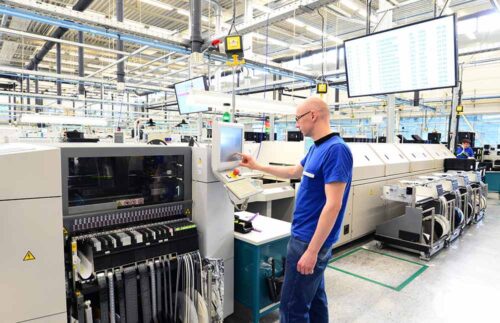6 Manufacturing Trends You Need to Know
 The global manufacturing sector has seen an upswing, a technological renaissance of sorts. Since the start of 2012, more people graduating from college and universities are entering the engineering/manufacturing fields.
The global manufacturing sector has seen an upswing, a technological renaissance of sorts. Since the start of 2012, more people graduating from college and universities are entering the engineering/manufacturing fields.
Breaking it down
In the U.S. alone, colleges and universities awarded 83,263 bachelor’s degrees in engineering in 2012, a 37% increase over the 60,605 degrees conferred in 2002. 1
In 2018, the three engineering disciplines producing the most degrees were, mechanical engineering, with 31,936 degrees, computer science with 19,082 degrees, and electrical engineering with 13,767,2 And in 2020, 199,790 degrees in engineering were awarded in the U.S.3
What’s the allure?
The engineering/manufacturing sector has a captivating attraction as a lucrative field for starting a career, thanks to technological developments and the exciting possibilities of working in industries like medical devices, electric vehicles (EV), aerospace and defense, consumer electronics, and biotechnology on cutting-edge products.
As the list of new technologies and innovative software solutions keeps mounting, graduates are excited by the prospects of learning and using new technologies like cloud CAD/CAM software, 3D printing, cloud-native product lifecycle management (PLM), quality management systems (QMS), and robotics.
With the expectations of landing an enticing career in the engineering/manufacturing sector, several trends and issues could impact your career path moving forward.
6 manufacturing trends you need to know
The Great Resignation
This recent trend began in 2021 when employees voluntarily left jobs in search of opportunities with better wages, working environments, and work-life balance. The manufacturing sector has been severely impacted by this trend because production jobs are highly technical. One of the top manufacturing trends for the near future will be the need to recruit, hire, and retain talent, especially from younger generations.
Cobots
Collaborative robots (Cobots) are designed to work together with people. They help complete tasks, improve productivity, and help make work more efficient. They have numerous sensors that work well around people and are built for safety. Cobots assist employees to work more productively rather than replacing the employee. They are lightweight, flexible, and simple to integrate, making them perfect for use in warehouses with limited room. The global cobot market size is estimated to be worth $866 million in 2022 and is forecasted to a readjusted size of $1682 million by 2028.4 Due to their low cost and simple design, cobots are also becoming widely used in supply chain management.
IIoT
The Industrial Internet of Things (IIoT), an extension of the IoT to industrial applications continues to be a major trend. IIoT is the connection of distinct devices within an existing internet infrastructure making it possible for manufacturers to make knowledgeable, strategic decisions using real-time data to improve cost reduction, efficiency, safety, product innovation, and more.
Big data
The use of big data is increasing in manufacturing. Manufacturers are leveraging big data to provide them with a comprehensive picture of their business thanks to the ability to acquire information from an ever-increasing variety of sources. Manufacturers can formulate data-driven decisions on sourcing, production, fulfillment, cost reduction, and other factors, especially if they have access to statistical insights. If they are unsuccessful, they can better understand what went wrong and adjust their strategy going forward.
Supply chain insourcing
Supply chain disruption seems to be a permanent condition. With rising inflation, driver and labor shortages, logistics problems brought on by factory closures, geopolitical conflicts in key sourcing regions, and changing weather patterns due to climate change that jeopardizes viable shipments, manufacturers are keen to make the best of a poor position—starting with insourcing. Some manufacturers are opting to cut out the middlemen by buying logistics firms or creating their own internal logistics operations rather than relying on third-party logistics providers to manage fulfillment. This strategy enables better supply chain visibility, superior quality control, forging closer bonds with the original equipment manufacturers that buy their products, and decreases shipping costs and time resulting in a more integrated supply chain.
Reshoring and near-sourcing
Many businesses are returning product manufacturing from foreign countries to their home countries (reshoring). Some are transferring work to different companies within their regions (nearshoring) while other companies are relocating business processes from one country to another (onshoring). Mexico’s proximity to the U.S. is helping to drive some of that momentum. In manufacturing, near-sourcing, often referred to as local sourcing, is the process by which a company moves activities closer to the market for its finished product. Typically, it means obtaining raw materials from domestic suppliers. Reshoring and near-sourcing will likely continue to dominate manufacturing trends in 2023 as businesses work to cut their reliance on imports completely or in part. The big push now is to get manufacturing and sourcing closer to home.

How cloud technologies drive manufacturing success
The Cloud has been a key driver of many of these transformative tech trends with little or no slowing down. Cloud computing is helping manufacturers not only improve efficiency but also supporting them in being competitive.
Here are the top 5 benefits of cloud technology for manufacturers
1. Increase in production numbers
The manufacturing industry’s primary process is mass production. It’s a field that demands great care and expertise and, if managed improperly, can result in significant losses. The cycle time from concept to prototype design, production, and delivery has been greatly accelerated by cloud technologies due to the practical data storage choices provided by cloud technologies. Manufacturers may now integrate supply chain information with product manufacturing plans.
2. Metrics monitoring
Real-time data can be accessed globally using cloud computing. It enables the quick collection of product KPIs like inventory information, raw material use, overall efficiency, and machine working efficiency. Manufacturers may be able to identify flaws early and take the necessary steps to improve product quality if monitoring metrics are improved. This procedure will aid the business in boosting profits and minimizing avoidable losses.
3. Enhanced compliance
There are numerous benefits related to compliance. Moving to the Cloud helps manufacturers meet many mandatory data compliance requirements. Compared to on-premises systems, cloud services are more secure and don’t need as many updates. The crucial updates are handled behind the scenes to prevent disruption of running operations. Since it is not immediately accessible, a database in the Cloud is more secure when using APIs.
4. Better data backup efficiency and recovery with cloud
Strategies for data backup and disaster recovery are essential for the manufacturing sector. For instance, the supply chain, which entails operations, purchasing, distribution, inventory management, etc., is a highly complex process. When creating catastrophe recovery methods, each of these should be considered. But because of the Cloud, everything is now much more effective and simpler. Cloud computing guarantees immutable data backups by default, simplifying the implementation of disaster recovery strategies for enterprises. Due to redundancy, cloud technology manages securely distributed backups of organizational data, ensuring that the data will survive even if one production site (or Cloud server location) goes offline due to an emergency.
5. Elevate stock planning and management
To maintain profitability, manufacturing, and stock maintenance are crucial steps that must be coordinated. Continuous supply chain cycles and stock inventory monitoring can both be made more effective with the help of the Cloud. It assists by giving up-to-the-minute supply chain updates. Additionally, by employing various techniques, the Cloud aids in determining customer expectations.
Ready for a new manufacturing era?
With more engineering graduates entering the field and advancements in manufacturing, companies can position themselves to become more efficient and more competitive with cloud solutions. Arena is ready to help new engineers and manufacturers speed the design and development of innovative products with a centralized system to connect all design and manufacturing teams and processes.
Sources cited:


